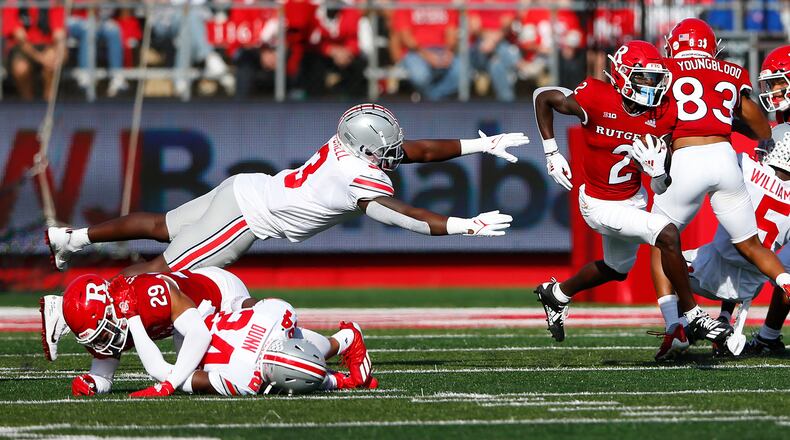1. They could not stop the run when it mattered.
Overall, Ohio State is 17th in the country in rushing yards allowed per game (118.5), a figure that would be 20 yards per game higher if not for sacks.
Ohio State held seven teams below 100 yards rushing, but Oregon and Michigan combined for 566 yards on the ground in wins against the Buckeyes.
The Ducks and Wolverines not only put up big numbers on the ground — they were efficient. Oregon averaged 7.08 yards per carry while the Wolverines went for 7.24. The latter figure is the fourth-highest in school history.
Historically bad run defense, missed mid-game opportunities doom Buckeyes at Michigan https://t.co/gtyGhBqZ2F
— Marcus Hartman (@marcushartman) November 29, 2021
2. They could not rush the passer when it mattered, either.
The raw numbers against Oregon and Michigan might not be so bad if Ohio State had been able to trim some yards off with sacks, but the Buckeyes had none in either game.
They averaged 3.0 sacks per game on the season to rank second in the Big Ten and 22nd in the country, but 10 of their 36 came against hapless Akron in Week 4.
3. An empty-calories offense.
With a game to go, Ohio State is on pace to set a Big Ten record for total yards per game (535.6) and passing yards per game (364.9) along with a school record for yards per play (7.8).
The Buckeyes are tied for No. 2 in school history in points per game (45.5) and scored on 50 of 54 trips to the red zone.
Finishing drives was a problem all year, though. In the first two weeks, they scored only two touchdowns in four red zone trips, a problem that returned in the second half of the season when the schedule got tougher.
At Michigan, they again settled for field goals on two of four times they got the ball inside the 20 while the Wolverines were six for seven in building an insurmountable lead.
On the season, Ohio State was seventh nationally in red zone scoring percentage (92.6) but only 38th in touchdown percentage (66.7).
That problem became more pronounced in the last five games as Ohio State settled for field goals on 12 of 25 red zone trips.
Ohio State football: Lots of time to reflect after sudden end to season https://t.co/zHsjMiwb4Q
— Marcus Hartman (@marcushartman) November 29, 2021
4. The running game was also unreliable.
Ohio State is a respectable fourth in the Big Ten in rushing yards per game (186.5) and an impressive third in the country in yards per rush (5.54), but this was another potential strength that came and went.
The Buckeyes had only 128 yards rushing in the loss to Oregon, 90 in a win at Nebraska and 64 in the loss at Michigan. Those were also the three games Ohio State failed to reach 30 points, and the ones in which quarterback C.J. Stroud threw his most passes on the season as head coach Ryan Day did not appear to trust the ground attack.
5. Little contributions from veterans.
Chris Olave had a team-high 13 touchdown catches, but he was one of few seniors to excel in a major role this season.
Returning All-American defensive tackle Haskell Garrett had a team-high 5.5 sacks, but three were against Akron and his production tailed off significantly in the second half of the season as he dealt with nagging injuries.
Junior Zach Harrison tied Garrett for the team lead with seven tackles for loss, but the five-star recruit did not have the breakout season many expected.
The same can also be said of a handful of veterans who entered the year looking to play large roles for the first time, including fellow linemen Tyreke Smith, Taron Vincent and Antwuan Jackson and senior linebackers Teradja Mitchell, Dallas Gant and K’Vaughn Pope.
Gant and Pope left the program midway through the season after being passed by younger players on the depth chart.
In the secondary, veteran cornerbacks Sevyn Banks and Cam Brown both missed multiple games with injuries and combined for 26 tackles and eight pass breakups while Josh Proctor’s presence was missed after the senior safety suffered a season-ending injury in Week 2 against Oregon.
About the Author

